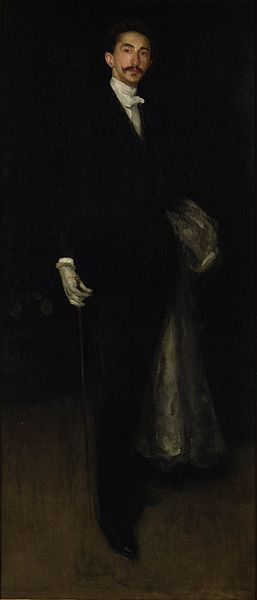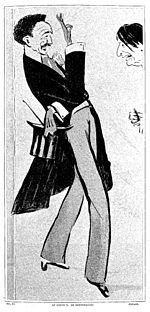Arrangement in black and gold

|
| Arrangement in Black and Gold: Comte Robert de Montesquiou-Fezensac |
|---|
| James McNeill Whistler , ca. 1891–92 |
| Oil on canvas |
| 208.6 x 91.8 cm |
| Frick Collection |
Arrangement in Black and Gold: Comte Robert de Montesquiou-Fezensac is a painting by the American painter James McNeill Whistler .
Depicted is the eccentric French dandy and writer Robert de Montesquiou , one of the most colorful exponents of the Belle Époque in France.
The painting was the subject of an exhibition that was shown from 1995 to 1996 under the title "Whistler and Montesquiou: The Butterfly and the Bat" at the Frick Collection in New York.
Provenance
The painting was in the possession of Montesquiou until 1902 when he separated from it due to financial problems. He sold it for 60,000 francs through the French art dealer Arnold Seligman to the American arcade owner and art collector Richard Albert Canfield (1855-1914), who informed Whistler of the purchase. Canfield had met Whistler in 1899 when he was trying to get hold of as many of Whistler's works as possible on his trip to Europe. Shortly before his death, Canfield sold his Whistler collection for $ 300,000 to the art dealer Roland F. Knoedler (1856–1932), who in 1914 sold them to the Frick Collection.
description
The picture in a very narrow vertical format shows Robert de Montesquiou at the age of approx. 35 against a dark background. Dressed in a black evening suit and black patent leather shoes, he hardly stands out against a diffuse, deep dark background that brightens to a blackish gray-brown towards the floor. His face, the white shirt with the stand-up collar and the artfully tied neck tie are illuminated by bright light that falls in from the top left of the picture. Bright light also falls on the right hand with the fine gray leather glove and a narrow strip of cuff that flashes between the jacket sleeve and the glove.

The hand carelessly holds a thin stick that barely touches the ground. This baton was apparently one of Montesquiou's usual going out gear, as he carries it with him in many pictures, photos and caricatures. Heavy fur, the chinchilla cape of his cousin Élisabeth Greffulhe (1860–1952), which shimmers golden in the falling light , hangs loosely over his left forearm, which he has supported on his hip .
On the floor to the right is a vase with three large white umbels, probably the hydrangeas valued by Montesquiou, with which he used to lavishly decorate his apartment on rue Benjamin Franklin.
Robert de Montesquiou
Montesquiou was the offspring of a Gascon family from the old nobility; his ancestors include the Marshal of France Blaise de Montesquiou and d'Artagnan, who is well known from Dumas' novel The Three Musketeers . Montesquiou stylized himself as a dandy, staged his appearances in society, where he moved between aristocracy, high finance, demi monde and the scene of artists, writers and music, as a living work of art.
On July 3, 1885, Whistler and Montesquiou met through Henry James's mediation at the Reform Club in London . A little later Montesquiou asked the painter to portray him. Whistler agreed, but the portrait sessions did not take place in Whistler's Paris studio until the spring of 1891. The following summer the picture was completed, but remained in the studio for two years until it was shown for the first time in 1894 at the Salon du Champ-de-Mars , where it aroused lively interest from the public and the specialist press. As a thank you for the successful portrait, Montesquiou wrote a polyphonic poem entitled Moth , which was printed in one of his poetry collections in 1892. Moth is a reference to the butterfly Whistler had been using as a signature since 1869 .
Montesquiou owes his literary fame less to his own works than to the reflection in fictional characters of his time. The main character in Huysman's novel Against the Grain, the decadent-morbid Duke Jean Floreasses des Esseintes, has Montesquious traits. The most famous literary figure inspired by Montesquiou is the Baron de Charlus in Marcel Proust's novel In Search of Lost Time , as is his nephew Robert de Saint-Loup, who becomes more and more like Charlus with age, and of whom it is in the last volume of Research means:
“He became more and more like her [his mother]; the haughty slimness which he had inherited from her and which was perfect in her, appeared to him, as a result of the most perfect upbringing, exaggerated and rigid; the penetrating gaze peculiar to all Guermantes made him look as if he were inspecting all the places in which he moved [...] Even when he was standing still, gave him that special color that made him more than all the rest of Guermantes and nothing but the abundance of the sun turned into matter on a golden day, something like a strange plumage, assigned it to such a rare, precious species that one would have liked to have it for an ornithological collection ... "
Literature and Sources
- Edgar Munhall: Whistler & Montesquiou. Flammarion, Paris 1996, ISBN 2-08-013577-5 .
- Günter Erbe : dandies, virtuosos of the art of living: a story of sophisticated life . Böhlau, Cologne 2002, ISBN 3-412-05602-2 .
- Marcel Proust : Time found again . From d. Franz. Transl. by Eva Rechel-Mertens , revised. by Luzius Keller . Frankfurt am Main 2011, p. 16.
Web links
- The Frick Collection
- Richard Albert Canfield, 1855-1914. University of Glasgow.
- Whistler's Approach to Portraiture and Influence from Diego Velazquez
Individual evidence
- ^ The Frick Collection , accessed August 15, 2015.
- ↑ James McNeill Whistler, ed. University Glasgow ; Victoria Charles: James McNeill Whistler, p. 149.
- ↑ James McNeill Whistler - Arrangement in Black and Gold: Comte Robert de Montesquiou-Fezensac. collections.frick.org, accessed March 26, 2014 .
- ↑ Whistler Correspondence, Univ. od Glasgow
- ^ A Bat Smithsonian libraries, accessed August 25, 2019
- ↑ The Moth. Robert de Montesquiou. From d. Franz into English transl. by Jeffrey Jullich. Text online , accessed on August 24, 2019
- ↑ James McNeill Whistler, Twelve butterflies. Hunterian Museum and Art Gallery, University of Glasgow. ( Memento from November 10, 2013 in the Internet Archive )
- ^ Antoine Bertrand: Les curiosités esthétiques de Robert de Montesquiou . Vol. 1. Geneva Ed. Droz 1996, p. 119.